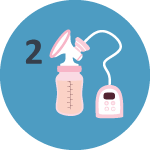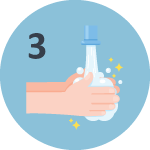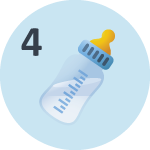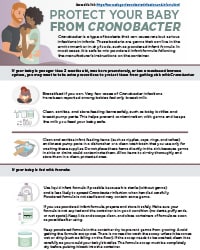Cronobacter Infection and Infants
Find information for families during the infant formula shortage.
Getting sick from Cronobacter does not happen often, but infections in infants can be deadly. Cronobacter infections in infants less than 12 months old are often linked to powdered infant formula. If you feed your baby powdered infant formula, you can take steps to protect your baby from sickness.
Where Cronobacter Comes From
Cronobacter sakazakii is a germ found naturally in the environment.
These germs can live in dry foods, such as:
- Powdered infant formula
- Powdered milk
- Herbal teas
- Starches
Getting sick from Cronobacter does not happen often, but infections in infants can be deadly. Cronobacter infections in infants less than 12 months old are often linked to powdered infant formula. If you feed your baby powdered infant formula, you can take steps to protect your baby from sickness.
Find information for families during the infant formula shortage.
Powdered formula is not sterile and might have germs in it.
Powdered infant formula can get contaminated in homes or in processing facilities that make it.

In the home:
You can accidentally get Cronobacter in powdered formula after you open the container. Cronobacter can live on surfaces in your home, such as a kitchen counter or sinks, and in water. In the home, Cronobacter could get into powdered formula in these ways:
- If you place formula lids or scoops on contaminated surfaces and later touch the formula.
- If you mix the formula with contaminated water or in a contaminated bottle.

In a processing facility:
Cronobacter can also get into powdered infant formula in a processing facility in these ways:
- If the manufacturer uses contaminated ingredients to make the formula.
- If the formula powder touches a contaminated surface.
Understanding Your Baby’s Risk
Cronobacter infections are rare, but they can be life-threatening in newborns. Infections in infants usually occur in the first days or weeks of life. About 2 to 4 cases are reported to CDC every year, but this figure may not reflect the true number of illnesses. That’s because most hospitals and laboratories are not required to report Cronobacter infections to health departments.
Cronobacter germs can cause a dangerous blood infection (sepsis). They can also make the linings surrounding the brain and spinal cord swell (meningitis).
Infants who are more likely to get sick include:
- Infants younger than 2 months. These infants are most likely to develop meningitis if they get sick from Cronobacter.
- Infants born prematurely.
- Infants with weakened immune systems. Babies with this condition can’t fight germs as well because of illness or medical treatment, such as chemotherapy for cancer.
Cronobacter illness in infants usually starts with a fever and poor feeding, excessive crying, or very low energy. Some infants may also have seizures. You should take an infant with these symptoms to a medical provider as soon as possible.

Breastfeed if you can. Very few cases of Cronobacter infections have been reported among infants fed only breast milk.

Clean, sanitize, and store feeding items safely. Germs can grow quickly if you add breast milk or formula to a partially used bottle or only rinse a used bottle, rather than clean it.
You can help keep your baby’s milk safe by carefully cleaning, sanitizing, and storing feeding items such as baby bottles, breast pump parts, nipples, caps, rings, valves, and other objects that may enter the baby’s mouth, like pacifiers and teethers. Take apart bottles and breast pump equipment after use so you can clean them thoroughly.

When cleaning surfaces, you may also use a disinfectant wipe or paper towel sprayed with cleaning product. Do not place feeding items directly in the sink, because germs in sinks or drains could contaminate these items.
Keep hands and surfaces clean! Before preparing and feeding bottles or food to your baby, it is important to clean surfaces, like countertops and sinks, with soap and water and to wash your hands with soap and water for at least 20 seconds. You should also wash your hands during these key times:
- Before touching your baby’s mouth
- Before touching pacifiers or other things that go into your baby’s mouth
- After using the toilet or changing diapers
If soap and water are not available, use a hand sanitizer with at least 60% alcohol. Check the product label to be sure.
Wash hands with soap and water as soon as possible after using hand sanitizer. Hand sanitizer with at least 60% alcohol kills Cronobacter. But hand sanitizer does not kill all types of germs. It may not work as well if hands are visibly greasy or dirty.

Prepare and store your formula safely.
If you feed your baby with formula, consider using liquid formula when possible, especially if your baby is at higher risk. Powdered infant formula is not sterile and might have germs in it.
Liquid infant formula is made to be sterile (without germs). This means liquid formula should not make your baby sick with Cronobacter infection when you follow the instructions on the container.
You do not need to warm infant formula before feeding, but some people like to warm their baby’s bottle. If you do warm the bottle, never use a microwave. Microwaves heat milk and food unevenly, resulting in “hot spots” that can burn your baby’s mouth and throat.

Make sure your formula is not expired or recalled. The container should be in good condition with no dents, puffy ends, or rust spots.
To warm a bottle, place it under warm running water. Keep the running water from getting into the bottle or on the nipple. Put a couple drops of infant formula on the inside of your wrist to make sure it is not too hot.
If you feed your baby with powdered infant formula, it is even more important to keep surfaces, feeding items, and your hands clean to prevent germs that can make your baby sick from getting into the formula container.
Don’t set the formula scoop on the counter, in the sink, or on any other surface. Keep lids and scoops clean and completely dry, and close containers of formula as soon as possible after using them.
In most cases, it is safe to mix powdered infant formula following the manufacturer’s instructions on the container. But if your baby is at higher risk, consider taking these extra steps to prepare your powdered formula with hot water (at least 158°F/70°C):
- Boil water and let it cool for about 5 minutes. It is important to mix the formula while the water is still very hot so that the heat can kill any germs.
- Pour the water into a clean bottle or feeding cup.
- Add the exact amount of formula listed on the container. Then, put a cap on the bottle and shake to mix. Don’t use a spoon or other utensil to stir because this could introduce germs.
- Cool the formula to body temperature to ensure it is not too hot before feeding your baby. Hold the capped bottle under cool water or place it into an ice bath. Do not let the cooling water get into the bottle or on the nipple.
- Test the formula’s temperature by putting a few drops on the inside of your wrist. It should feel warm, not hot.
Use prepared infant formula within 1 hour from start of feeding and within 2 hours of preparing it. Throw away any formula your baby does not finish. Don’t refrigerate leftover formula to save it for later. The combination of the formula and your baby’s saliva can allow germs to grow.
If you do not plan to start feeding your baby with the prepared formula right away, put it in the refrigerator immediately. Use formula in the refrigerator within 24 hours. Throw out formula if you can’t remember how long you have kept it in the refrigerator. Do not feed it to your baby.
For more information, visit CDC’s Infant Formula Preparation and Storage web page.
- How to Prepare and Store Powdered Infant Formula During an Emergency | Nutrition | CDC
- How to Clean, Sanitize, and Store Infant Feeding Items
- Breastfeeding
- How to Keep Your Breast Pump Kit Clean: The Essentials
- Printable Fact Sheet: How to Keep Your Breast Pump Kit Clean – English [PDF – 2 pages] and Spanish [PDF – 2 pages]
- How to Keep Your Breast Pump Kit Clean: Science Behind the Recommendations
- Proper Storage and Preparation of Breast Milk
- WHO: Safe preparation, storage, and handling of powdered infant formula guidelines
- People at Risk: Children Under Five
